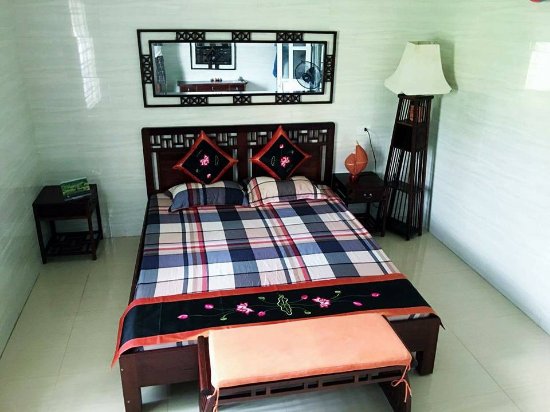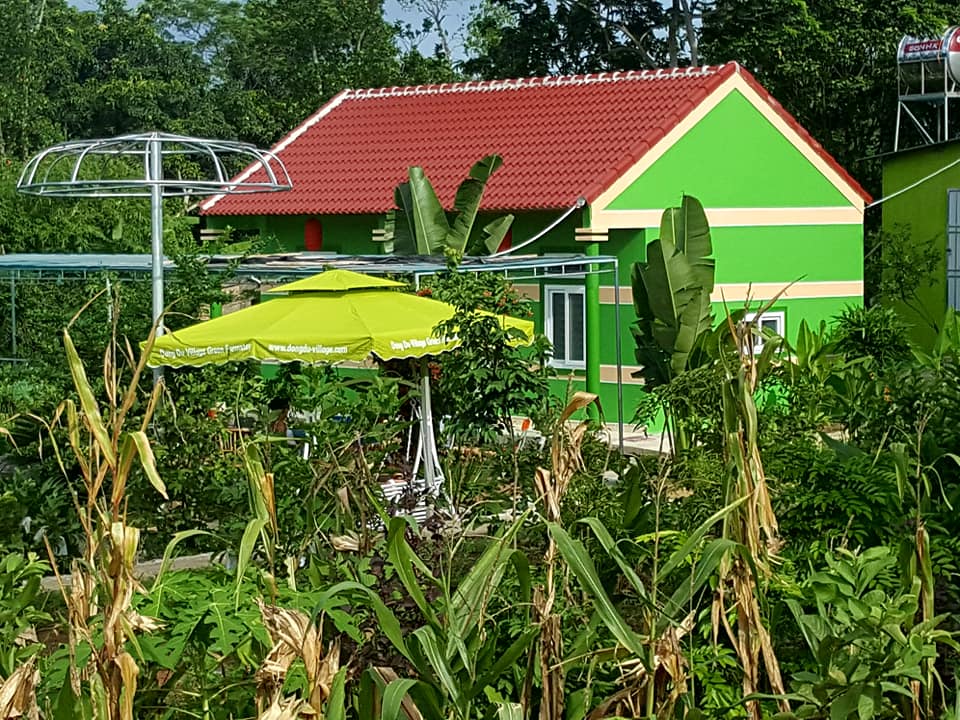Travel Blog
Dong Du Village Lakeside Farmstays
The biodiversity of Western Nghe An Biosphere Reserve
Updated: 20/3/2020 | 10:52:51 AM
Covered by more than 1.3 million hectares of natural forest and spreading over nine mountainous districts, the Western Nghe An Biosphere Reserve is the only remaining area in northern Vietnam boasting a large expanse of well-preserved primary forest. It is also the largest Biosphere Reserve in South East Asia. The reserve creates a green corridor through Pu Mat National Park – a storehouse of fauna and flora species, Pu Huong and Pu Hoat Nature Reserves.
State, province, region or other administrative units - Western Nghe An
Region: Socialist Republic of Vietnam
Province: Nghe An
District: Anh Son, Con Cuong, Tuong Duong, Quy Chau, Quy Hop, Que Phong, Ky Son, Thanh Chuong, Tan Ky
Sub - district:
The Proposed Biosphere Reserve has area of about 1,303,285 ha and covers nine mountainous districts including Con Cuong, Anh Son, Tuong Duong, Que Phong, Quy Chau, Quy Hop, Thanh Chuong and Tan Ky. The proposed Biosphere Reserve has been designed based on the criteria to perform three functions of internationally Proposed Biosphere Reserves, the development strategy of the country, the commitment of Nghe An provincial People’s Committee in implementing the Convention of Biological Diversity (CBD) and Agenda 21 national project. The Proposed Biosphere Reserve has 440.8 km friendship border with Laos People’s Democratic Republic. Therefore, there is an opportunity for building a Transboudary Biosphere Reserve after reaching an agreement between the governments.
The bio-geological area of the Proposed Biosphere Reserve belongs to the ecological system of tropical rainforest with 12 forms of ecological system recognized by UNESCO – MAB. The remaining primary tropical rainforests in this Proposed Biosphere Reserve are still a very precious heritage despite the fact that these forests have undergone a lot of past and on-going stresses, including the resistance war against the French, the anti-American war, illegal logging of timber by forest thieves and exploitation by the poor local people whose livelihoods are forest-dependent. This remained preserved vast and diverse primary tropical forest is clearly indicative of strong commitment and exertion of local government and people to protect forests in an age where other regions have let go with economic development at the expense of the forest.
This is the largest in comparison to the Biosphere Reserves recognized and in the system of Reserves in Viet Nam. It is built based on the ideas about the principle of preserving overall landscape with space separated between three protected areas (including a National Park and two special Nature Reserves), which will be inter-connected by buffer zones. The large area of the remaining primary forest, including the part where people have never set foot on will be the place for scientist and researchers to discover new species and species that are endangered of extinction, such as the Pseudoryx nghetinhensis. The inhabitants of the Proposed Biosphere Reserve include ethnic groups such as: Thai, Dan Lai (Ly Ha), Kho Mu, O Du, H’Mong and Kinh. In particular, the O Du account for only 528 people (according to the survey result on 30/12/2003) who are continuously in decline and who live in very difficult situation. These ethnic groups have remained in the region before the 11th century, who possesses distinguishable culture of Nam Non – Nam Mo – Ca River confluence. Furthermore, the area marked the last limit of Thai people when emigrating to the South. The Proposed Biosphere Reserve will play a part in developing the economy, increasing living standards through green tourism activities, scientific research, awareness-raising and environment education activities and also in preserving national cultural characteristics.
The Western Nghe An Proposed Biosphere Reserve include Pu Mat National Park and 2 Pu Huong and Pu Hoat Nature Reserves, which are divided between nine administrative mountainous districts of the western Nghe An province following North – South axis. The Proposed Biosphere Reserve includes all Ca River head valley with 3 important effluents: Hieu River, Nam Non River and Nam Mo River. The areas belong to the ecological region of Annamite range. The ecological region of Annamite range stretches away between Viet Nam and Laos’s territory. Ca river-bed (Lam River) is the only hinge fault of Annamite ecological region that brings about diversified and plentiful complexity of Annamite ecosystem...
Building the Western Nghe An Proposed Biosphere Reserve will bring about a corridor that preserves biodiversity including flora and fauna of international and national importance as mentioned in IUCN and Viet Nam Red Book (section about the Northern Annamite biodiversity). Based on criteria for priority ranking of conservation system, the Proposed Biosphere Reserve is one of the top ranked regions of conservation system in Viet Nam.
The Western Nghe An Biosphere Reserve is home to more than 2,500 flora species, 130 mammals, 295 bird species, 54 amphibians and reptiles, 84 fish species, 39 bat species, and thousands of different insects. Thanks to its rich biodiversity, the Reserve has been recognized as a typical tropical forest with varied habitats including mountains, wetlands, and streams. Ho Duc Phoc is Deputy Secretary of Nghe An Province’s Party Committee: “We are honored that Pu Mat National Forest has been recognized as a world biosphere reserve. It is one of seven biosphere reserves in VN recognized by UNESCO for ecological and cultural values. With its diversity of plants and animals, the Reserve richly deserves this recognition”.
The Reserve is populated by ethnic minority groups of Thai, Mong, Tay Poong, and Kho Mu, with their unique traditional customs and festivals. The Reserve was recognized by UNESCO in 2007, but it wasn’t until April 2011, that the Nghe An People’s Committee officially announced UNESCO’s recognition. Nguyen Thanh Nhan, Director of the Pu Mat National Park explains the reason: “Why did we wait until now to declare the UNESCO recognition? First, we wanted to make the entire community aware of the fact that it requires a long process to gain this recognition. Second, the time is now ripe for the declaration. Since its recognition in 2007, any activities relating to the Western Nghe An Biosphere Reserve have received serious interest from the provincial People’s Committee and relevant agencies. We understand that the recognition brings an honor and a brand name, but what we must focus on now is how to sustain this brand”.
It’s really hard to be recognized as a world biosphere reserve, it’s even harder to conserve the achievement, and to ensure its sustainable growth. Tourism development is considered one effective way to give the provinces containing this reserve some economic benefits. The raising of community awareness and the active involvement of authorities at all levels are prerequisites for preserving and tapping the reserve efficiently. Pham Quoc Quan is Director of the Revolutionary Museum: “VN is facing a big problem in the preservation and upholding of the values of heritages and reserves in the community. If we don’t have a good protection plan, any investment in the reserve will be wasted”.
Professor Nguyen Hoang Tri is Secretary General of the National Committee of the Vietnamese Human and Biosphere Programme: “We should know that a biosphere reserve is a voluntary co-operative reserve created to protect the biological and cultural diversity of a region while promoting sustainable economic development. It is a place of co-operation, education and experimentation, where scientists and managers can share research data to better understand man’s impact on nature. We should balance these fundamental functions. We now have compiled materials to guide us in combining culture in the biosphere reserve. Regarding this work, I think the provincial Culture, Sports and Tourism Department should play a key role in linking the preservation of biosphere diversity and culture in the region”.
The UNESCO recognition is of significance as it offers the reserve and its region a so-called ‘brand-name’ in terms of biodiversity and the culture of the local ethnic groups. It’s also an acknowledgement of local efforts to protect forests and preserve the local culture, offering new opportunities for preservation activities in Nghe An Province. Professor Nguyen Hoang Tri again: “Through the recognition, VN has proven its initiative in preservation. That is to create a corridor among the three core zones of the Western Nghe An Biosphere Reserve. The corridor will help preserve rare birds, animals, insects and other species sustainably. The corridor will create a cultural space for the region that encourages local people to be involved more in conservation. In addition, it will offer a chance for climate change research”.
As a result of the recognition, there is likely to be more investment in biodiversity researches that could lead to new discoveries that increase the value of the Reserve. Nguyen Thanh Nhan, Director of the Pu Mat National Park again: “This reserve is important in terms of preservation, sustainable development and logistics. Particularly, any provinces which are located in or near the reserve will receive many investment projects for preserving biodiversity and local cultural identities”
You’ve been listening to the Sunday Show on the Voice of Vietnam. In this week’s edition, we introduced to you the Western Nghe An Biosphere Reserve which has been recognized by UNESCO for its ecological and cultural value. Next week, we’ll give you an in-depth look at the culture of ethnic people living in the region and at the responsible tourism in Dong Du Eco Farmstay
(Source: Dong Du Eco Farmstay)
Other news
- Explore Western Nghe An while staying in Dong Du Eco Farmstay
- For a green Lan Ha bay & Halong Bay
- A Different Way of Life in Cai Beo Fishing Village - Lan Ha Bay
- Phu Xai Lai Leng mountain
- Le sommet Phu Xai Lai Leng et la Chaîne Annamitique
- Unique and authentic homestay tours delight foreigners in Thai Hoa and Quy Chau, Nghe An
- Découverte du parc national de Pù Mat- réserve biosphérique mondiale
- Discover Pu Mat Natural Park and Fatherland of HCM
- Dong Du Eco Farmstay and Pu Mat National Park
- It takes a village: The changing face of tourism in rural Vietnam











